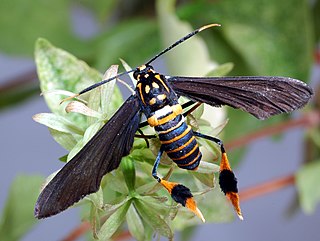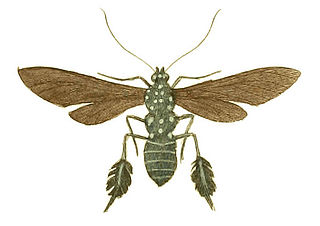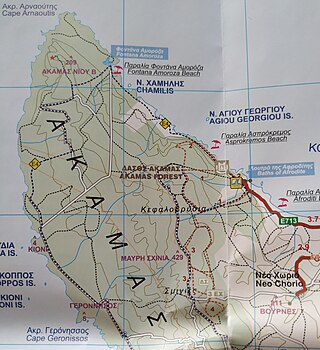
The Transfiguration of Jesus is an event described in the New Testament, where Jesus is transfigured and becomes radiant in glory upon a mountain. The Synoptic Gospels recount the occasion, and the Second Epistle of Peter also refers to it.

Augustus Radcliffe Grote was a British entomologist who described over 1,000 species of butterflies and moths. He is best known for his work on North American Noctuidae. A number of species were named after him, including the moth Horama grotei.

Horama is a genus of tiger moths in the family Erebidae first described by Jacob Hübner in 1819.

Robert Barker was a painter from Kells, County Meath, Ireland, known for his panoramic paintings and for his coinage of the word "panorama".

Horama panthalon, the Texas wasp moth, is a moth of the subfamily Arctiinae. The species was first described by Johan Christian Fabricius in 1793. It is found in South America, Central America, Mexico, the Antilles and southern United States.
Helena Lisická was a Czech ethnographer and writer, author of fairy tales and legends. She started her production in 1950s and wrote more than 20 writings. Outside fairy tales she wrote some plays for children. She collaborated with Folklore group Haná, together they founded folklore festival Lidový rok. Her husband was archivist Antonín Roubic.
Horama pennipes is a moth in the subfamily Arctiinae first described by Augustus Radcliffe Grote in 1866. It is found on Cuba.
Horama diffissa is a moth in the family Erebidae first described by Augustus Radcliffe Grote in 1866. It is found in Cuba and Haiti.
Horama oedippus is a moth of the subfamily Arctiinae. It was described by Jean Baptiste Boisduval in 1870. It is found in Mexico and Guatemala.

Horama plumipes is a moth of the subfamily Arctiinae. It was described by Dru Drury in 1773. It is found in southern Texas, Mexico, Honduras, Belize, Guatemala and Nicaragua.
Horama tarsalis is a moth of the subfamily Arctiinae. It was described by Francis Walker in 1856. It is found on Haiti.
Horama grotei is a moth of the subfamily Arctiinae. It was described by Arthur Gardiner Butler in 1876. It is found on Jamaica. This species was named in honor of Augustus Radcliffe Grote.
Horama pretus is a moth of the subfamily Arctiinae. It was described by Pieter Cramer in 1777. It is found on the West Indies and in Venezuela.
Horama margarita is a moth of the subfamily Arctiinae. It was described by Timothy L. McCabe in 1992. It is found in Cuba.
Horama rawlinsi is a moth of the subfamily Arctiinae. It was described by Timothy L. McCabe in 1992. It is found in the Dominican Republic and Haiti.

The Euchromiina are a subtribe of tiger moths in the family Erebidae. It was described by Arthur Gardiner Butler in 1876. Many species in the subtribe are mimics of wasps. Euchromiina have always been considered closely related to the subtribe Ctenuchina due to their similarity to moths and wasps. These two subtribes make up around 3,000 valid species, the majority of which occur in the Neotropics.
Tsiárta is a mountain in Tsada village in the Paphos District of Cyprus, situated at 605 m elevation. It is east of Melissóvounos. The highest part is located 613 m above sea level. It is near Asprovounaro. The average annual rainfall is 572 millimeters. The wettest month is January, with an average of 123 mm of precipitation. The driest month is August, with 2 mm of precipitation. The terrain around Tsiárta is mainly hilly.

Mavri Sinia or Mavri Schinia is a mountain in Neo Chorio in the Paphos District of Cyprus. Its peak elevation is 429 metres (1,407 ft) above sea level. The terrain around Mavri Schinia is hilly on the east, but flat in the west and the sea is in the northwest. Lára is the highest point nearby at an elevation of 669 metres (2,195 ft). The average rainfall here is 631 millimetres (24.8 in) annually. January is the wettest month with an average of 141 millimetres (5.6 in) precipitation. August is the driest with only 2 millimetres (0.08 in) precipitation. The nearest larger community is Pegeia 17.7 kilometres (11.0 mi) south of Mavri Schinia. Neo Chorio is 4.4 kilometres (2.7 mi) from Mavri Schinia.

Lara or Lára (Greek:Λάρα) is a mountain in Ineia in the Paphos District of Cyprus. Is located at 669 m above sea level. The terrain around Lára is mainly hilly. The nearest larger community is Empa, 17.7 km south of Lára. It receives 631 mm of rainfall annually.

Makrona is a mountain in Tsada in the Paphos District of Cyprus. Is located at 564 m above sea level. Titsiros is only 1.4 km away and Agrioelia at 2.6 km away. The nearest larger city is Pafos, 8.1 km southwest of Makrona. The area around the Makrona consists mostly of agricultural land. The average rainfall here is 573 mm annually. January is the wettest month. August is the driest with only 2 mm.








